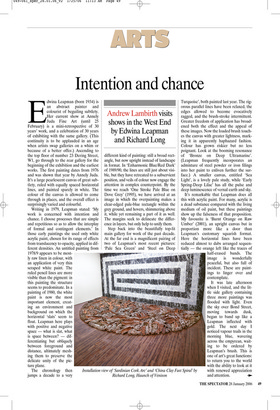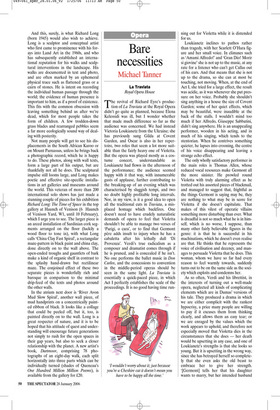Intention and chance
Andrew Lambirth visits shows in the West End by Edwina Leapman and Richard Long
Edwina Leapman (born 1934) is an abstract painter and colourist of beguiling subtlety. Her current show at Annely Juda Fine Art (until 25 February) is a mini-retrospective of 30 years’ work, and a celebration of 30 years of exhibiting with the same gallery. (This continuity is to be applauded in an age when artists swap galleries on a whim or because of a better offer.) Ascending to the top floor of number 23 Dering Street, W1, go through to the rear gallery for the beginning of the exhibition and the earliest works. The first painting dates from 1976 and was shown that year by Annely Juda. It’s a large pearlescent canvas of great subtlety, ruled with equally spaced horizontal lines, and painted sparely in white. The colour of the canvas is allowed to come through in places, and the overall effect is surprisingly varied and colourful.
The chronology then jumps a decade to a very different kind of painting: still a broad rectangle, but now upright instead of landscape in format. In ‘Enharmonic Blue/Red Dark’ of 1989/90, the lines are still just about visible, but they have retreated to a subservient position, and veils of colour now engage the attention in complex counterpoint. By the time we reach ‘One Stroke Pale Blue on Dove Grey’ (1995), we have arrived at an image in which the overpainting makes a clear-edged pale-blue rectangle within the grey ground, and hovers, shimmering above it, while yet remaining a part of it as well. The margins seek to delineate the difference in layers, but only help to unify them.
Step back into the beautifully top-lit main gallery for work of the past decade. At the far end is a magnificent pairing of two of Leapman’s most recent pictures: ‘Pale Sea Green’ and ‘Steel on Deep Turquoise’, both painted last year. The rigorous parallel lines have been relaxed, the edges allowed to become evocatively ragged, and the brush-stroke intermittent. Greater freedom of application has broadened both the effect and the appeal of these images. Now the loaded brush touches the canvas with greater lightness, marking it in apparently haphazard fashion. Colour has grown riskier but no less poignant. Look at the booming resonance of ‘Bronze on Deep Ultramarine’. (Leapman frequently incorporates an admixture of steel powder or iron filings into her paint to enliven further the surface.) A smaller canvas, entitled ‘Sea Light’, is a lovely pale study, while ‘Early Spring-Deep Lilac’ has all the pulse and deep luminescence of vernal earth and sky.
It’s remarkable that Leapman does all this with acrylic paint. For many, acrylic is a dead substance compared with the living medium of oil paint, but these paintings show up the falseness of that proposition. My favourite is ‘Burnt Orange on Raw Umber’ (2001), an upright canvas but in proportion more like a door than Leapman’s customary squarish format. Here the horizontal lines have been reduced almost to dabs arranged sequentially — the orange left like the traces of half-erased bands. The image is wonderfully peaceful, but also full of incident. These are paintings to linger over and contemplate.
It was late afternoon when I visited, and the little side gallery containing three more paintings was flooded with light. Even the sky over Bond Street, moving towards dusk, began to band up like a Leapman inflected with gold. The next day I noticed vapour trails in the morning blue, wavering across the empyrean, waiting to be ordered by Leapman’s brush. This is one of art’s great functions: to return you to the world with the ability to look at it with renewed appreciation and attention. And this, surely, is what Richard Long (born 1945) would also wish to achieve. Long is a sculptor and conceptual artist who first came to prominence with his forays into Land Art in the 1960s, and who has subsequently established an international reputation for his walks and sculptural interventions in the landscape. His walks are documented in text and photo, and are often marked by an ephemeral physical trace such as flattened grass or a cairn of stones. He is intent on recording the individual human passage through the world; the evidence of human presence is important to him, as if a proof of existence. This fits with the common obsession with leaving something behind us after we’re dead, which for most people takes the form of children. A few trodden-down grass blades and rearranged pebbles seem a far more ecologically sound way of dealing with posterity.
Not many people will get to see his displacements in the South African Karoo or on Mount Parnassus, unless he brings back a photographic record, which he is happy to do. These photos, along with wall texts, form a large part of his output, but are thankfully not all he does. The sculptural impulse still looms large, and Long makes poetic and effective site-specific installations in art galleries and museums around the world. This veteran of more than 200 international solo shows has just made a stunning couple of pieces for his exhibition Richard Long: The Time of Space in the top gallery at Haunch of Venison (6 Haunch of Venison Yard, W1, until 10 February), which I urge you to see. The larger piece is an arced installation of Sardinian cork segments arranged on the floor (luckily a wood floor to tone in), with what Long calls ‘China Clay Fast Spiral’, a rectangular maze-pattern in black paint and china clay, done directly on to the wall above. The open-ended troughs and gauntlets of bark make a kind of organic shelf in contrast to the splashy hand-drawn but rectilinear maze. The conjoined effect of these two separate pieces is wonderfully rich and baroque in comparison to the minimal drip-feed of the texts and photos around the other walls.
In the atrium next door is ‘River Avon Mud Slow Spiral’, another wall piece, of mud handprints on a concentrically painted ribbon of black. It looks like a collage that could be peeled off, but it, too, is painted directly on to the wall. Long is a great respecter of nature, and it is to be hoped that his attitude of quest and understanding will encourage future generations not simply to rush for the open spaces in their gap years, but also to seek a closer relationship with the planet. A new artist’s book, Dartmoor, comprising 78 photographs of an eight-day walk, each split horizontally into three parts which can be individually turned (shades of Queneau’s One Hundred Million Million Poems), is available from the gallery for £20.























































 Previous page
Previous page